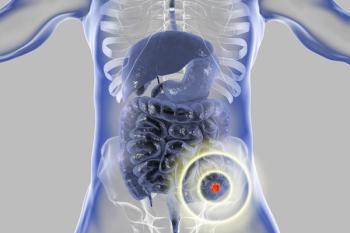
Oncology NEWS International
- Oncology NEWS International Vol 13 No 3
- Volume 13
- Issue 3
Advancing Treatment of GI Cancers
This special “annual highlights” supplement to Oncology News International is acompilation of some of the major advances in the management of gastrointestinalcancers during 2003–2004, as reported in ONI. Guest editor Dr. James L. Abbruzzesecomments on the reports included herein and discusses advances in the clinicalmanagement of GI cancers, with a focus on developments in targeted therapy, newcombinations, adjuvant therapy, and what to watch for in 2004.
The past year has witnessedimportant advances in chemotherapyfor colorectal cancerand continued maturationof molecular approachesto management of other GImalignancies. This specialsupplement to ONI highlightsresearch in adjuvant andneoadjuvant therapy, with new strategies and drugcombinations for improving outcomes; targeted therapy;reports on potential new biomarkers and vaccines;and interesting epidemiologic findings in pancreaticvs colorectal cancer.Chemotherapy in Colorectal CancerIn the following text and elsewhere in this supplement,a number of combination chemotherapy regimensare discussed. For your convenience, these regimensare defined in the glossary on page 3.FOLFOX: The N9741 trial demonstrated the superiorityof the FOLFOX regimen over the IFL regimen infirst-line treatment of metastatic colorectal cancer (CRC),forming the basis of FDA approval of oxaliplatin(Eloxatin) in this regimen and setting.Subsequently,the large-scale phase III MOSAIC trial showed thebenefits of FOLFOX4 extend to the adjuvant setting(see report on page 6).Over 3 years of follow-up, FOLFOX4 was associatedwith improved disease-free survival and reducedrisk of recurrence vs LV/5-FU2 in advanced CRC, withbenefits observed in patients with stage II and stage IIIdisease and in all other patient subsets. Overall, 3-year disease-free survival was 77.8% in the FOLFOX4arm and 72.9% in the LV/5-FU2 arm. No increases inmortality or vascular events during adjuvant therapywere observed with FOLFOX4 vs LV/5-FU2.However, FOLFOX4 was associated with relativelyhigh frequencies of grade 3/4 neutropenia (41%),grade 3 sensory neuropathy during treatment (12%),and any-grade neuropathy at 1 year (29%). In adjuvantchemotherapy regimens, oral capecitabine(Xeloda) may represent a substitute for 5-FU/LV offeringsignificant advantages in regard to the toxicityobserved with FOLFOX, without loss of effectiveness.In a planned safety analysis of the X-ACT trialcomparing oral capecitabine vs 5-FU/LV as adjuvanttherapy in metastatic colon cancer, capecitabine producedsignificantly less grade 3/4 neutropenia (2%and 3% in patients < 65 and ≥ 65 years vs 26% and27%, respectively) and significantly less stomatitis, butmore frequent hand-foot syndrome (see page 5).XELOX: The combination of capecitabine plusoxaliplatin has indeed been shown to be active inadvanced CRC. In an international phase II trial inpatients with metastatic CRC, first-line treatment withXELOX produced a response rate of 55%, progression-free survival of 7.7 months, overall survival of19.5 months, and 1-year survival of 71% (see page12). Neutropenia was observed in only 7% of patients,and grade 3/4 hand-foot syndrome was observedin 3%. An ongoing phase II trial in patientsaged > 70 years has also shown good activity ofXELOX as first-line treatment, with observed neuropathy(grade 3 neuropathy in 11%) tending to resolvewithin 2 weeks (see page 9). An additional phase IItrial by Austrian researchers suggests benefits in progression-free survival (10.5 months vs 6 months) witha dose-intense XELOX regimen vs one using standarddosecapecitabine as first-line treatment of metastaticdisease. The dose-intense regimen was not associatedwith any significant increase in hematologic ornonhematologic toxicity (see page 10).Capecitabine/irinotecan: Capecitabine has alsoshown promise in replacing infusional 5-FU/LV in theIFL and FOLFIRI regimen as a partner with irinotecan(see page 7). In an ongoing phase II multicenter study,continuous, flat-dose capecitabine plus weeklyirinotecan as first-line treatment for metastatic or locallyadvanced disease resulted in objective response in31% and stable disease in 31% of 49 evaluablepatients; currently, median time to disease progressionis 5.4 months and median overall survival is 16.7months. No grade 3/4 neutropenia was seen.In another recently reported phase II study, first-linetreatment for metastatic disease with a XELIRI regimenproduced an objective response rate of 46%; grade 3hand-foot syndrome was observed in only 6% of patients,and grade 3/4 neutropenia in 25%.Neoadjuvant TherapyGastric cancer: In an NYU study in patients withlocally advanced gastric cancer, cisplatin (Platinol)/irinotecan was given prior to surgery and intraperitonealfloxuridine (FUDR)/cisplatin given after surgery(see page 18). Neoadjuvant therapy resulted in tumordownstaging in more than 50% of patients, but completeresponse was observed in only 1 of 32 evaluablepatients. Nearly all patients had some form of grade3/4 toxicity, 16 with grade 3/4 neutropenia.Rectal cancer: The large-scale German RectalCancer Study in patients with locally advanced rectalcancer found preoperative chemoradiation therapy(5-FU chemotherapy) is associated with improvedoutcomes vs postoperative chemoradiation therapy(see page 11). Preoperative therapy was associatedwith a reduced 5-year rate of local recurrenceand improved sphincter preservation. No significantdifferences were seen in the 5-year rates of distantrecurrence, disease-free survival, or overall survival.The frequencies of grade 3/4 toxicities weresimilar, but the preoperative group had lower ratesof severe diarrhea and a reduced frequency ofchronic anastomotic site stenosis.Molecular ApproachesTargeted therapy: In a phase III trial in previouslyuntreated patients with metastatic CRC, the additionof the vascular endothelial growth factor inhibitorbevacizumab (Avastin) to IFL treatment resulted in increasedresponse rate (45% vs 35%), overall survival(20.3 vs 15.6 months), time to disease progression(10.6 vs 6.2 months), and response duration (10.4 vs7.1 months) compared with IFL alone (see page 13).Bevacizumab was well tolerated. Grade 3 hypertensionoccurred in more bevacizumab-treated patients(10.9% vs 2.3%). GI perforation was a rare adverseevent seen only in the bevacizumab group; while manyof these episodes were apparently not life-threatening,bowel perforations have been seen in other studiesand further studies to understand the pathogenesis ofthese episodes are warranted.On February 26, 2004, Genentech, Inc. announcedFDA approval of Avastin in combination with IV 5-FUbasedchemotherapy for first-line or previously untreatedmetastatic colorectal cancer (see page 10).In a large randomized phase II trial in patients withendothelial growth factor receptor (EGFR)-positive metastaticCRC who had progressed on irinotecan treatment,the addition of the EGFR monoclonal antibodycetuximab (Erbitux) to irinotecan resulted in improvedresponse rate (22.9% vs 10.8%), stable disease rate(55.5% vs 32.4%), and time to disease progression(4.1 vs 1.5 months) vs cetuximab alone; survival durationdid not differ significantly (8.6 vs 6.9 months),perhaps partly reflecting elective cross-over to combinationtherapy from the monotherapy group at time ofdisease progression (see report on page 13).The most frequent grade 3/4 toxicities in the combinationarm were diarrhea and neutropenia; the mostfrequent serious side effects in the monotherapy armwere asthenia and acneiform rash, with rash observedto correlate with both objective response and survival.The results of this study and other studies of cetuximabin this patient population supported recent FDA approval for cetuximab monotherapy or cetuximab/irinotecan for second-line management of advancedcolorectal cancer (see page 10).Vaccines: At ECCO, investigators reported interestingphase I findings in patients with resected pancreaticcancer who received a vaccine derived fromheat shock proteins taken from each patient's owntumor (see page 20).In 10 evaluable patients, autologous vaccinationwith HSPPC-96 had no significant toxicities and apparentsurvival benefits: average survival after surgeryfor pancreatic cancer is 14 to 15 months;median survival in this small group has been 2.5years, with 1 patient disease-free after 5 years. Thevaccine, in phase III trials in renal cell carcinoma andmetastatic melanoma, is also being evaluated incolorectal and gastric cancer.Biomarkers: There is a wide array of candidatemolecular markers for poor outcome and poor responseto 5-FU in colon cancer. Data from ECOG/intergroup trials in stage III disease indicated improvedoutcome with 5-FU treatment in patients withretained chromosome 18q alleles (eg, DCC, Smad 4,Smad 2) (5-year survival 74% vs 50% in those withoutthe allele) and in those with microsatellite instability(MSI) with a transforming growth factor (TGF)-?1-RIImutation (74% vs 46% in those with MSI but noTGF-?1-RII mutation) (see page 15). In other research,telomerase may be an early marker forpancreatobiliary malignancies, with a telomeraseimmunostaining technique of potential use as a screeningtool (see page 23).Aspirin in Pancreatic vs Colorectal CaSurprising findings were reported in late 2003regarding aspirin, which the large-scale Nurses' HealthStudy found may increase risk of pancreatic cancerwhen taken over long periods of time (see page 24).In colorectal cancer, however, other studies, includingthe Nurses' Health Study, concluded that regularuse of aspirin (and NSAIDs) is protective (see page17). While randomized controlled clinical trials areneeded before conclusions can be drawn, investigatorsindicated the results may partly reflect biologicdifferences between these two types of GI cancer.Emerging OpportunitiesIt is increasingly clear that GI cancers-some of themost challenging of all human malignancies-are respondingto novel cytotoxic combinations and the firstgeneration of targeted therapeutics. It is logical toassume that as our basic knowledge of GI malignanciesexpands, new opportunities will continue toemerge. Further, the improving therapeutic index ofthe targeted agents may allow development of practicalstrategies for introduction of these interventionsearlier in the carcinogenic process, potentially at apoint in the natural history of a malignancy when thebeneficial therapeutic effects may be even morepronounced.James L. Abbruzzese, MD
M. G. and Lillie A. Johnson Chair
for Cancer Treatment and Research
Professor of Medicine
Chairman, Department of Gastrointestinal
Medical Oncology
The University of Texas M. D. Anderson Cancer Center
Houston, Texas
Articles in this issue
almost 18 years ago
Panitumumab effective in normal KRAS subsetover 21 years ago
XELOX Combination Is ‘Highly Active’ in Biliary System Cancersalmost 22 years ago
FDA Approves Erbitux for Advanced Colon Caalmost 22 years ago
FDA Approves Alimta/Cisplatin for Malignant Mesotheliomaalmost 22 years ago
Topotecan/Cisplatin Improves Cervical Cancer Survivalalmost 22 years ago
Multigene Assay Predicts Breast Ca Recurrencealmost 22 years ago
2004 Sees FDA Approval of Two Tumor Growth Inhibitors for Colorectal Canceralmost 22 years ago
Neoadjuvant Therapy Is Promising for Locally Advanced Gastric CancerNewsletter
Stay up to date on recent advances in the multidisciplinary approach to cancer.





